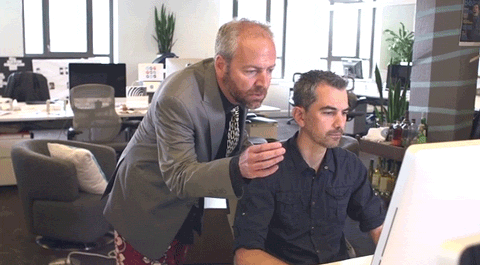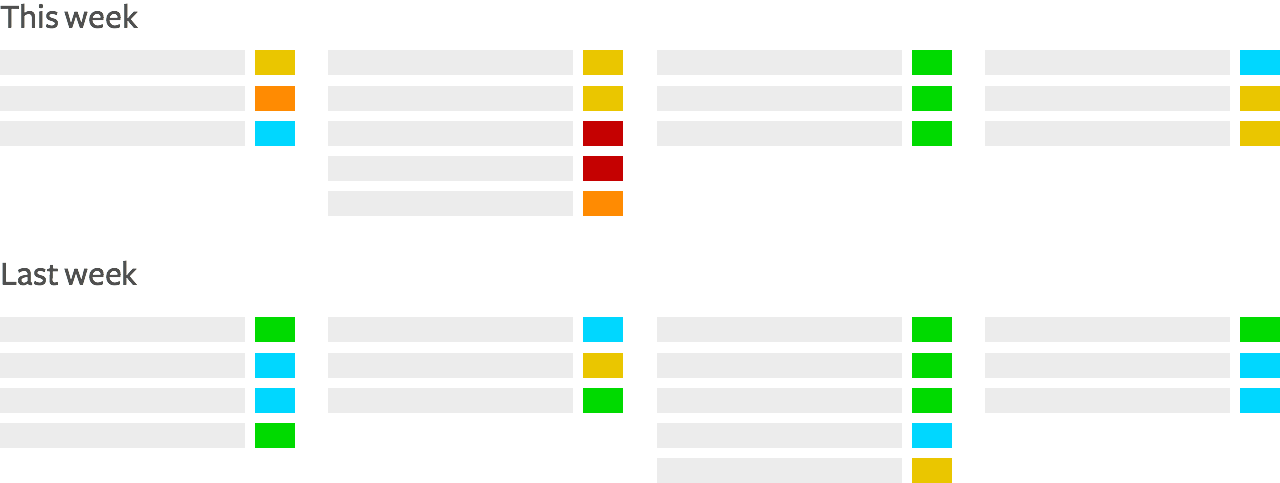Three months ago, I switched jobs from being a Product Designer to leading the Product Design team at DigitalOcean. I say “switched jobs” rather than “was promoted” because in my mind it’s more accurate. My new role isn’t a step up, it’s a step sideways into a totally different world. Like most first time managers, I have no idea what I’m doing, so I’m experimenting. If it works, great. If it doesn’t work, we’ll scrap it and try something else.
This post is about one of the most successful experiments thus far. Throughout it, I’ve sprinkled a lot of my thoughts on what makes a good manager.
You should totally read it.
A word on trust
Throughout these experiments, there is one north star that guides me — a management style if you will — and that’s trust.
Having trust in my team to do their jobs. They’re awesome and they don’t need me micromanaging them.
Earning the trust of my team by following through when I say I’ll do something.
The specific workflow I’m about to discuss is built around this relationship. It’s called “Goalfest.” Yeah, I know what you’re thinking.
…
…
…
What a goddamn awesome name.
What is Goalfest?
Goalfest is what happens when you combine two of the most exciting things the business world has to offer: meetings and spreadsheets. It goes like this:
At the end of every week, my team gathers in a room for a meeting dubbed Goalfest. During said meeting, we collectively fill out a spreadsheet with, you guessed it, goals.
In turn, we each write our respective goals for the upcoming week. These are self-driven goals based on what each person knows will be on their plate. Occasionally, but not often, I will add to these goals with additional tasks I need them to accomplish.

We each go over the status of the goals we set last week. This part is extremely useful when members of the team are working on different parts of the product and might not be aware of everything that’s happening.
We rate the completion of each of our goals on a scale of 1–5. Although this is in a public forum, each member of the team is rating themselves. The hope is for every single goal to be a shiny green 5, though this is not usually the case considering we use Goalfest to stretch ourselves and find out what we’re capable of.

We discuss what we can improve for the next time round. This is basically a retro in which we draw lessons from the week. Why wasn’t something completed? Could something have been done differently? Let’s try that next time.
So what makes a successful Goalfest?
Goalfest is for learning, not for keeping score
The main objective of Goalfest is to provide insight into the way we work. How much can we take on and be successful? What can we do to avoid over-promising? What can we do to be more efficient?
As such, grades on the spreadsheet are there to help analyze the way we work and will never find their way into a performance review. It’s key that everyone involved understands this. Goalfest is a tool for getting shit done, not for evaluating who’s getting shit done. If it were the latter, you’d never see another stretch goal. It’s clearly safer to get a comfortable amount of work done than to fail at exceeding that. You don’t want to scare your team out of growing.
Coming back to the experimental nature of my process, we realized early on that rating ourselves on progress wasn’t enough in itself to help us improve week over week. We added a “Lessons Learned” section at the bottom of each week, which has since become a formal part of Goalfest. Now, when we can’t complete one of our goals, we add a comment on it (the wonders of Google Sheets). If we recognize a pattern, we add it to the Lessons Learned section.
This helped us understand, for instance, that the goals that involve assistance from other people are usually the ones that end up not getting done. The lesson we learned was to prioritize these goals for the start of the week. We haven’t had a problem with it since.
A few weeks into Goalfest and people on your team will have a better understanding for the amount of work they can take on and accomplish. You’ll get a better sense for how much bandwidth your team has and for what to expect. You’ll see less 1–3s and more 4–5s. You’ll see a heightened sense of responsibility in everyone involved.
Goalfest is for the team, not the manager
There’s a reason each person rates themselves. Goals in this context are promises. They’re tasks that the individuals of your team have guaranteed that they will accomplish. Not completing these tasks is tantamount to breaking a promise. If we’re being dramatic.
But these aren’t promises to the manager. Each person is promising themselves, and they’ll be letting themselves down if they fail. (Keep in mind: failing is both acceptable and expected).
The Product Design team doesn’t belong to me. We’re all part of it, and its success is a reflection of the work we all do together. As such, everyone is equally responsible for the team doing well. They don’t care about this because of me. They care because it’s their team.
Doing something for your boss? What a weak motivation compared to doing it for yourself.

Goalfest should be front and center
When tasks are hidden, they’re infinitely harder to get done. Holding yourself to a large amount of work is hard enough without having to search for it. That’s why we do everything to make it as salient as possible.
The current week is always first. Every week we push everything down and insert a new week on top. The result is a long list of weeks in reverse chronological order, with the current week’s always in your face.

Goals should be ordered by priority. Things on the top are more important and/or will take longer. This makes it easy to choose what to work on first. After the first week, we added a divider at the bottom of each list. Everything above the divider is guaranteed to be done during the week. Things below the divider are either stretch goals or stuff that comes in during the week. This differentiator can also help us understand in retrospect why something wasn’t done. For instance, many urgent things came in mid-week.

Use it throughout the week. This one’s optional, but Goalfest is an awesome way to stay up to date on your team’s progress throughout the week. You should wholeheartedly encourage your team to update scores and comments for their goals right when things change. You’ll be able to catch problems and assist. A mid-week 1:1 is also a great place to discuss current progress and how you can help.
Goalfest is equal
Listen up, because this part is crucial. The first column on the spreadsheet is where I write my goals. Remember that trust thing I was talking about 3 or so sections ago? This is part of that.
Just like everyone else, I set my goals for the week, and just like everyone else, I rate myself on how well I did.
So why do I participate?
It confirms that Goalfest is about improving rather than evaluating. We’re all learning how to be better together.
Management work is often harder to see, and this is a good place to show that I’m down in the trenches with them, even if the work is different.
Most importantly, I’m a part of the team. It’s really as simple as that.
If you want your team to care about killing it, lead by example and care yourself. Otherwise, you can’t and shouldn’t expect more from anyone else.
Goalfest can only work with trust
Trust is key in self-driven teams. That’s why I participate in Goalfest and that’s why everyone on the team self-rates. We’re all in it together and we all have a shared goal: to ship an awesome product. That’s why it doesn’t devolve into a competition for who has the most 5s. For Goalfest to work, you need your team to intrinsically care about what they’re making, and the way you set your team’s responsibilities is instrumental to that.
My role as head of Product Design is figuring out our high level product design vision, advancing our design processes, working on our internal style guide, growing the team, and ensuring everyone is happy and productive. When I’m lucky, I get to work on design projects. What’s not included in my job description is making sure that subtasks on a certain project are on schedule.
At DigitalOcean, every Product Designer is part of a product team. On these teams, Product Managers prioritize what needs to happen in order to succesfully ship the products and features we’re working on and Product Designers own the design process. These partnerships result in a strong feeling of ownership over a certain product vertical. Rather than having an assignment handed from the top-down, designers on my team are responsible for their own assignments and for completing these. I’m not there to check up on them. I’m there to coach them and push them to be their best. They decide what that means.
The only way this structure can work is with trust, and the only way to attain this level of trust is by hiring the right people. That’s an entirely different post, though.
So you want to Goalfest?
I thought about making an app for this, but figured that’d just be another tool to add to the pile of tools you’re already not using.
Instead, I’m open sourcing this spreadsheet, by which I mean the workflow itself. Feel free to copy it an use it for your team.
Now, by no means do I think that this is a perfect system. It’s still very young and has only ever been tested with my team. I highly recommend you experiment and see if you can improve on it. I’d love to know how it works for your team. Discuss on Designer News or hit me up on Twitter and let’s chat!
Also, if this sounds like the kind of team you want to join, we’re totally hiring.
Joel led Product Design at DigitalOcean. Now he makes GitHub.
He doesn't write often, but when he does, he makes it count.
Sign up below for:
✅ Sneak peeks at upcoming design articles.
✅ Exclusive content and bonus material.
✅ Weekly Q&A with your questions about design, career development, etc.
✅ Access to the archives 🙃